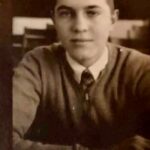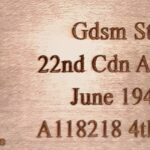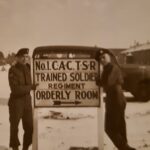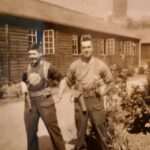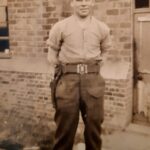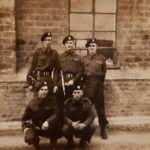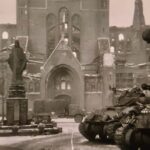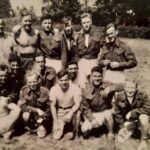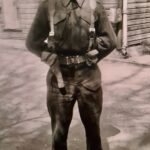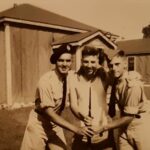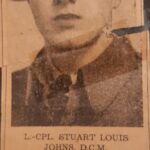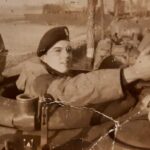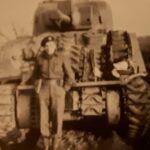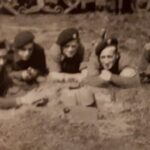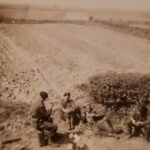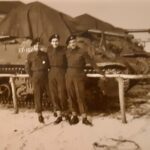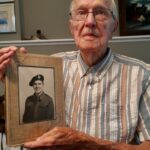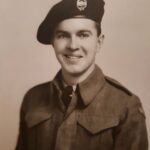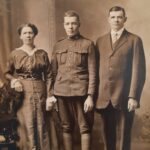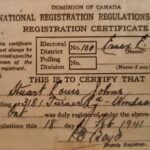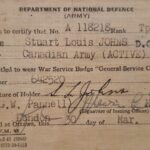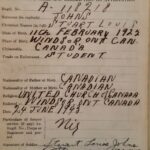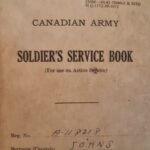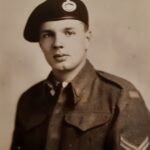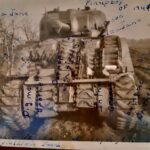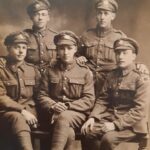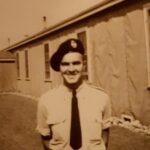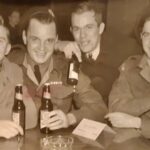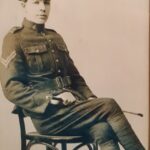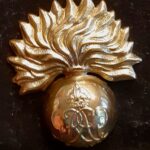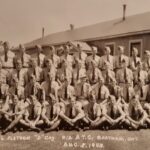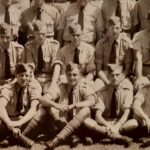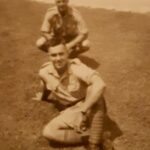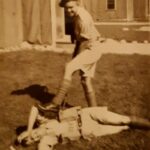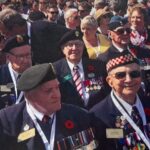Stuart Johns was born February 11, 1925 in Walkerville, Ontario. He grew up in and around Windsor, against the backdrop of the Great Depression. Stuart recalls his family being affected by that calamity – but also that they were not living in poverty. His father, a veteran of the Great War, worked at the nearby Hiram Walker Distillery, and he was able to keep his job as a stationary engineer – thanks to the demand for spirits, as Stuart recalls. Stuart’s childhood was normal for the time; he attended school, and he and his friends kept busy, enjoying Saturday matinees when they were able. They were aware of the war underway in Europe, expecting to play their part one day. Stuart’s older brother came of age first, but an injury delayed his enlistment. Stuart completed high school, and he and two friends walked down to the local armoury and joined up; while many of the high school graduates had opted for the RCAF, Stuart chose the army and was off to basic training in Chatham. The next step was advanced training at Camp Borden, and here they got their first taste of the armoured corps, if not yet the Sherman. From there Camp Windsor in Nova Scotia beckoned, a brief respite before going overseas. The troop ship that took Stuart to Greenock was the New Amsterdam, and Stuart recalls a miserable voyage where he was seasick most of the way, able to subsist on oranges that his friends managed to procure for him. Once in England he recovered quickly and he was initially stationed at Woking and Aldershot before being assigned to the Grenadier Guards of the 4th Armoured Division. Here he would finally become familiar with the Sherman tank, as Stuart was trained as a loader-operator. April-June 1944 would be a critical few months for Stuart, learning his role and meeting the other crew members and running schemes – it would set the stage for the events of the summer, as Stuart was about to play his role in the Battle of Normandy. They arrived on Juno Beach on July 26, 1944, about 7 weeks after D-Day. After a few days they were moved to the western sector of the Juno beachhead, near Bayeux. They would end up playing a role and seeing their first action in the Canadian operations of early August, Totalise and Tractable. Their tank was knocked out in the advance: Stuart and the crew were temporarily out of the fight, waiting on a recovery effort. After spending time in a tank recovery unit they were back at it, and on the front lines of the Battle of Falaise Pocket, where Stuart managed to take several German prisoners when out on a patrol. Falaise was one of the more intense battles of the Normandy campaign, and the Germans began their retreat Stuart and the 4th Armoured pursued them, crossing the Seine River near Elbeuf. Not long after this they pulled off the road along with other tanks and service corps trucks to resupply; while they were there they came under mortar fire and Stuart’s tank commanding officer – Corporal Vern Boudreau – was mortally wounded. The Grenadier Guards and Stuart Johns would follow the path of the Canadian army along the coastline through Belgium and Netherlands, seeing monumental combat in places such as the Scheldt. At war’s end the Grenadier Guards were in Germany, waiting for the final battles to conclude. The front had stalled at the Kusten Canal at this point, and Lance Corporal Johns was involved in an attack that aimed to break that stalemate. For his heroic efforts Stuart would be awarded the Distinguished Conduct Medal (DCM), the final chapter in a war that was just about over. Soon he would be back in Canada, ready to join the postwar rhythms of Canadian life. Stuart Johns was interviewed by Scott Masters in August 2022, at his home in Windsor, Ontario.
Videos
Click next video below to keep watching
- 1. Early Life in Windsor
- 2. Depression and War
- 3. Canada Declares War
- 4. Choosing the Army
- 5. Camp Borden
- 6. On to Nova Scotia; The Troop Ship
- 7. April 1944
- 8. Assigned to the Grenadier Guards
- 9. Tank Training
- 10. Crossing the Channel
- 11. In the Fight
- 12. Recovery
- 13. Back in the GHID; Falaise
- 14. An Encounter
- 15. Crossing the Seine
- 16. The DCM
- 17. The Worst Day
- 18. Telling the Story; Remembrance
